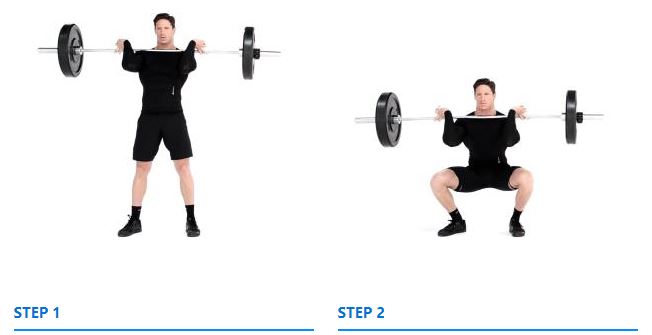Overview:
The barbell front squat is a powerful multi-joint compound exercise that helps to increase size and strength in the lower body. The primary focus is on the muscles located on the front of the thighs when performing this movement and it’s a fantastic exercise to include in your CrossFit WODs (workout of the day).
Muscles Targeted:
When you perform a front squat with a barbell, the tension is mainly focused on the primary muscles of the quadriceps, which are commonly referred to as the “quads”. However, as you are performing this exercise, there are additional muscles that help in the general movement and these are referred to as “synergistic” or “secondary” muscles. In this exercise, the secondary muscles are the gluteus maximus (butt muscles), the adductor magnus found in the inner thighs and the soleus which is located in the calves. Other secondary muscles that are engaged during this exercise include the hamstrings (to a lessor extent when compared to a traditional barbell squat), the lower back and the shoulders (to hold the barbell in position during the exercise).

- It is highly recommended that this exercise is performed using a squat rack for safety purposes. To begin, start by setting the bar on the rack at a height suitable for you. Once the correct height is attained and the bar is loaded, put your arms under the bar while ensuring your elbows are high and your upper arms are positioned parallel to the floor. Place the bar on top of the front deltoids (shoulders) and cross your arms while getting complete control of the bar by grasping it firmly with your hands.
- Remove the bar from the rack and take a few steps away from the squat rack in order to have enough room to execute the movement.
- Take a shoulder width stance with your feet pointed slightly out. Always keep your head up and your eyes looking straight forward because looking down may cause you to lose balance. In addition, looking straight ahead helps you maintain a correct spine angle which starts with your head position. This will be your starting position before you begin the actual squat.
- Start to slowly but steadily lower the bar by bending your knees, while maintaining a straight posture with your head in a fixed position.
- Focus on keeping your butt out, shoulders back and your chest out as you lower your body down into the squat position. You should try to keep your back as flat as possible (do not round your back).
- Your knees should be positioned slightly outward as you squat down (do not let them bend inward).
- Continue down until the upper legs are about parallel to the floor, which is the point at which the angle between the calves and the upper legs is in a position that forms a 90 degree angle.
- From the bottom position, start to raise the bar back up while exhaling and pushing off the floor by mainly using the middle part of your feet as you straighten your legs and return to the starting position.
- Repeat the movement until the recommended number of repetitions are completed and then place the barbell back onto the rack.
Things To Avoid:
- Not keeping your head straight and your back flat. Failure to do this may cause you to fall forward with the barbell. This can also cause you to lean forward, putting more pressure on the back and knee joints. If performed the incorrect way over a long period of time, it could ultimately lead to degeneration of the knee and spinal problems.
- Limiting the range of motion. It’s important to squat all the way down to 90 degrees. If the full range of motion is not reached, the muscles will not be properly engaged and optimal growth will not occur. However, your overall flexibility and range of motion will dictate how low you can squat down. Make sure to stop if you feel pain or discomfort.
- Locking your knees at the top. By extending completely and locking out your knees, you are giving your muscles time to relax before the next repetition, and more importantly, you are transferring the tension from the quadriceps to the knee joints which is something you definitely want to avoid.
- Moving too fast. When performing this exercise too quickly or with fast and jerky movements, you risk injury. Always use a slow and controlled tempo when performing this exercise.
- Using too much weight. When one is performing the barbell front squat, the centre of gravity is not in the normal position as it is when doing the traditional barbell squat which makes this exercise much more difficult to execute. Start with a very light weight on the barbell when first starting out to gauge your level of strength.
Reps and Sets:
You should choose a workout regimen that works best for your specific needs and goals. If your goal is overall strength and power then focus on lower repetitions in the 4-6 range. If your goal is muscle growth then the rep range will be higher (8-12 reps per set). Total sets of the barbell front squat should be around 4-5 when combined with 2-3 other leg exercises. The amount of sets for your entire leg workout should be around 12-15 sets.

